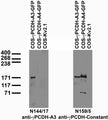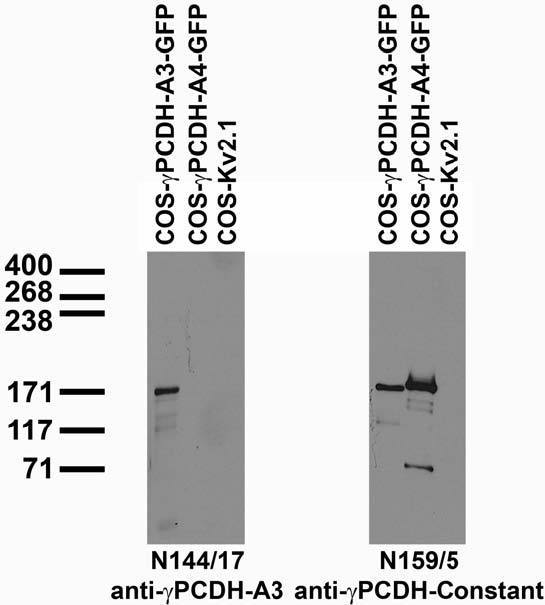Anti-Gamma-Protocadherin-A3 Antibody (N144/17)
Our Anti-Gamma-protocadherin-A3 mouse monoclonal primary antibody from NeuroMab is produced in-house from hybridoma clone N144/17. It is KO validated, detects mouse Gamma-protocadherin-A3, and is purified by Protein A chromatography. It is great for use in ICC, WB.
Mouse
ELISA, ICC, WB
Mouse
SKU: 75-177
Ships: 1-2 business days
Product Details
Gamma-protocadherin-A3
Protocadherin gamma A3 is encoded by the gene Pcdhga3. Gamma-protocadherins belong to a superfamily of homophilic cell-adhesion proteins. These cell adhesion proteins are thought to be involved in establishing and function of cell-cell connections in brain. Gamma-Protocadherin-A3 is a type I transmembrane receptor and is a calcium-dependent cell-adhesion protein. Gamma-Protocadherin-A3 plays a role in the establishment and maintenance of specific neuronal connections in the brain. Gamma-Protocadherin-A3 is expressed in the central nervous system where it localizes to synapses. Diseases associated with this gene include Pineal Gland Cancer.
Purified by Protein A chromatography
1 mg/mL
Monoclonal
N144/17
IgG1
ELISA, ICC, WB
Mouse
Pcdhga3
100 kDa
Fusion protein amino acids 720-804 (variable cytoplasmic domain) of mouse Gamma-protocadherin-A3 (accession number Q91XY5) produced recombinantly in E. Coli
Mouse
Mouse
AB_10671815
Aliquot and store at ≤ -20°C for long term storage. For short term storage, store at 2-8°C. For maximum recovery of product, centrifuge the vial prior to removing the cap.
Liquid
Produced by in vitro bioreactor culture of hybridoma line followed by Protein A affinity chromatography. Purified mAbs are >90% specific antibody.
10 mM Tris, 50 mM Sodium Chloride, 0.065% Sodium Azide pH 7.105
Unconjugated
No cross-reactivity against other Gamma-protocadherin-A, -B or -C proteins
Each new lot of antibody is quality control tested on cells overexpressing target protein and confirmed to give the expected staining pattern.
These antibodies are to be used as research laboratory reagents and are not for use as diagnostic or therapeutic reagents in humans.
United States
24 months from date of receipt
Protocadherin gamma A3 (Protocadherin gamma subfamily A, 3)
Shipped on ice packs
Product Specific References for Applications and Species
- Western Blot: Mouse
| Western Blot: Mouse | ||
| PMID | Dilution | Publication |
| 22884324 | not listed | Chen, W.V., et al. 2012. Functional significance of isoform diversification in the protocadherin gamma gene cluster.. Neuron, 402-409. |
| 22092001 | not listed | Lobas, M.A., et al. 2012. Molecular heterogeneity in the choroid plexus epithelium: the 22-member γ-protocadherin family is differentially expressed, apically localized, and implicated in CSF regulation.. Journal of Neurochemistry, 913-927. |



